'Living' biofilters could reduce greenhouse gas emissions
Naturally occurring microscopic organisms could cut emissions from Alberta industries
biofilters containing naturally occurring microscopic organisms that live on methane gas could help reduce hard-to-manage greenhouse gas emissions in the petroleum, forest and agriculture industries.
University of Calgary researchers plan to deploy and test inexpensive "methane biofilters" to reduce low-volume methane emissions at oil and gas field sites, landfills/sludge lagoons, livestock feedlots, forest industry landfills and oilsands operations.
The three-year project received $495,100 from the Climate Change and Emissions Management (CCEMC) Corporation though its Biological Greenhouse Gas Management Program. The program is managed on behalf of CCEMC by Alberta Innovates Bio Solutions.
"The problem is we don't yet have a cost-effective solution in these industries for these low-volume, low-quality methane emissions," says project lead Patrick Hettiaratchi, professor of environmental engineering in the University of Calgary's Schulich School of Engineering.
"Methane biofiltration is a clean and completely 'green' technology that offers a solution. The greenhouse gas benefit is that these biofilters convert methane to carbon dioxide," he says.
To control hard-to-manage emissions, researchers are looking to nature, where a family of bacteria called methanotrophs (which are found in soil, compost and other environments) uses methane as an energy source and, in doing so, coverts the gas to carbon dioxide.
"These bacteria will take the methane down to a few parts per million," or negligible levels, says Peter Dunfield, associate professor of biological sciences in the University of Calgary's Faculty of Science and a specialist in molecular environmental microbiology: the DNA-based monitoring of microbes in their natural habitat.
Carbon dioxide (CO2) is still emitted from the biofilters, but CO2 is about 25 times less potent as a greenhouse gas than methane. So keeping the methane out of the atmosphere would reduce the industry sectors' carbon 'footprint' and their greenhouse gas emissions' contribution to global warming.
The CCEMC estimates this project can reduce greenhouse gas emissions (as carbon dioxide equivalents or CO2e) in Alberta by about 2,000 tonnes over 10 years.
"The introduction of a novel technology to combat low-volume methane emissions that cannot be controlled using conventional methods will contribute immensely to achieving both Alberta and Canada's climate change goals," Hettiaratchi says.
At large-scale industrial operations producing a substantial volume of methane – such as a sour natural gas processing plant or a big municipal landfill – it is usually economic to collect the gas with small pipelines and use it as fuel.
But this approach isn't economically feasible for low-volume "point-source" methane emissions escaping from old oil and natural gas wellsites.
Each of these emission sources may be relatively small, but they add up. In 2010, 640 million cubic metres of methane were vented or flared from the petroleum industry alone in Alberta.
For the project, Dunfield and his laboratory team will use their well-established DNA 'fingerprinting' techniques to identify and count individual species in the microbial community inside each pilot methane biofilter at all the industrial sites.
That will enable the project team to optimize each biofilter's performance for the particular conditions at each site, and also to monitor over time each biofilter's performance in converting methane to CO2.
The use of methane-oxidizing bacteria in large covers, or "biocaps," installed atop landfills is currently being used to reduce methane emissions, the researchers note.
Much smaller methane biofilters work on the same principle. But the challenge has been to standardize design of these biofilters, optimize them for specific industrial sector applications, and provide sufficient knowledge on how to build and operate the filters to potential users, Hettiaratchi says.
The researchers will work closely with stakeholders from industry, government and other sectors to advance large-scale application of methane biofilters and deploy them "to control point-source emissions in a variety of situations."




























































